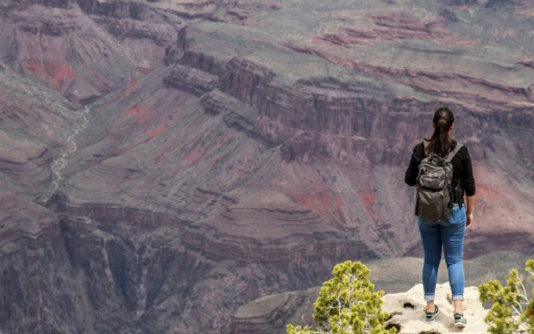GRAND CANYON NATIONAL PARK , Etats-Unis, June 7, 2019 (BSS/AFP) – Attention,
Grand Canyon visitors — watch your step before attempting a selfie from the
edge of the vertiginously deep and perilously steep US landmark.
The national park surrounding the enormous canyon — the second-most
visited US national park, after the Great Smoky Mountains in the country’s
southeast — has experienced a distressing surge in fatal accidents, with at
least four visitors dying in as many weeks in March and April.
The views that draw millions to the park in the high Arizona desert are
stunning, to be sure, both in their rich earth hues and in the sheer
immensity of the gap cleaved over eons by the unceasing Colorado River as it
winds sinuously through the canyon bottom.
But the views can also distract or disorient visitors — some of whom take
risks despite park rangers’ constant warnings — and the result can be fatal.
The body of a Japanese tourist was the first one found this spring,
located in a wooded area some distance from the rocky cliffs.
Then came three fatal falls, including that of a fifty-something tourist
from Hong Kong who toppled over the edge while snapping photos.
The park has placed protective barriers at some popular vista points, but
“we don’t want to put barriers everywhere,” park spokeswoman Kris Fister told
AFP. “The specialness about parks is not being enclosed.”
“You don’t have a barrier between you and this amazing place,” she added,
“but you have to pay attention.”
“We tell people to stay on the designated trails and walkways and to keep
a safe distance from the rim” — and of course, to pay attention when taking
pictures, said Fister, dressed in the gray military-style shirt and khaki
pants of a park ranger.
“That’s pretty common sense.”
But at the park’s Mather Point, which offers especially scenic views not
far from the visitor center on the canyon’s South Rim, the message does not
always get through.
This natural vista point, the most heavily visited in the park, may be the
spot in the US most often captured in visitors’ selfies.
From here to the canyon’s North Rim is a distance of 10 miles (16
kilometers).
There are protective barriers. But not far away, a young woman ventures to
the very edge of the cliff.
“We can see well enough from here,” British tourist Kathryn Kelly sniffs
dismissively, looking at the risk-taking woman. “I don’t see the point
stepping closer to the edge.”
“I heard of a man who died trying to take a selfie, and I’m struggling to
feel sorry for him,” Kelly said. “It’s a kind of natural selection.”
– Heat, suicides, snakebites –
Of the dozen people who, on average, die each year in the canyon,
relatively few fall to their deaths, according to park service statistics.
Most deaths are linked to the dramatic change in altitude and to
dehydration in the crushing summer heat faced by hikers — despite the
frequent warning signs that say things like “Don’t become a statistic” and
“Down is optional, up is mandatory.”
But for those who make it to the bottom of the canyon, near the turbulent,
muddy waters of the Colorado, Phantom Ranch offers a welcome oasis, a place
to rest and spend the night after long, draining hours of hiking.
Among the books on a shelf in the ranch’s dining room is one that lists
every death registered in the park: “Over the Edge: Death in Grand Canyon.”
Falls, flash flooding, drowning, storms, snakes, suicides, even murders
… there are as many ways to die in the Grand Canyon as there are ways to
photograph (and of course Instagram) it.
Jim Stanley, a 71-year-old from Michigan, read the book before taking on
this dangerous wonder of nature, where nearly seven million visitors are
expected this year for the 100th anniversary of Grand Canyon’s classification
as a national park.
“I haven’t been discouraged; I’m now aware of the risks,” he said, his
hiking pants proudly held up by a pair of suspenders in the red, white and
blue of the American flag.



